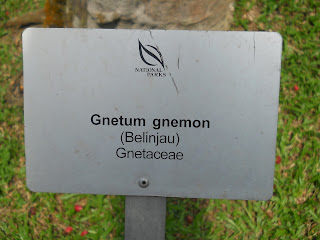The Bird's Nest Fern has a short stout erect rhizome (stem) which bears a rosette of simple, long, pointed leaves (fronds) to form a "nest". The stem is usually not visible from the top. The nest traps fallen leaves and other debris which eventually decompose to humus. Beneath the nest of fronds is a large spongy, mass of roots which are covered by the reflexed dead leaves. Rain water is soaked up and stored in the mass. In this way, the plant provides its own food and water and can continue to grow in a soilless condition as long as it is not left to dry out for too long. When the plant grows upward and outward and the root mass becomes deeper and spongier, it attracts other ferns, mosses or algae to grow on the root mass.
The fronds can grow to a length of more than a metre and a width of about 20 cm, with the whole plant extending to about two metres across. The leaves are in shiny light green colour, with a smooth-edged blade and a prominent black midrib. The reproduction sacs, or sporangia which produce spores, are formed along the veins on the underside of the mature fronds at a 45 degree angle in parallel rows to the midrib. The fern produces plentiful spores which are dispersed by wind for proliferation. It is believed to have originated from tropical Asia and Polynesia.
Usage and Potential:
Food: The Bird's Nest Fern is non-poisonous and is occasionally eaten by aboriginal tribe in Malaysia.
Medicine: The Malay used a decoction of the leaves to ease labour pains in childbirth and also to obtain a lotion to treat fever.
Other uses: The fern is now commonly grown for garden landscaping, either placed in trees as naturally found or on the ground as a garden plant. The plant is also used in flower arrangements with the whole plant or cut leaves used to enhance the arrangement.
Variant Names:
Common names: Bird's Nest Fern, Nest Fern.
Scientific name:
Asplenium nidus.
Malay names:
Daun semun, Paku langsuyar, Paku padan, Rumah langsuyar, Selimbar.
Chinese name:
Niao Chao Jue.
Sources From: http://infopedia.nl.sg/articles/SIP_389_2005-01-28.html





















